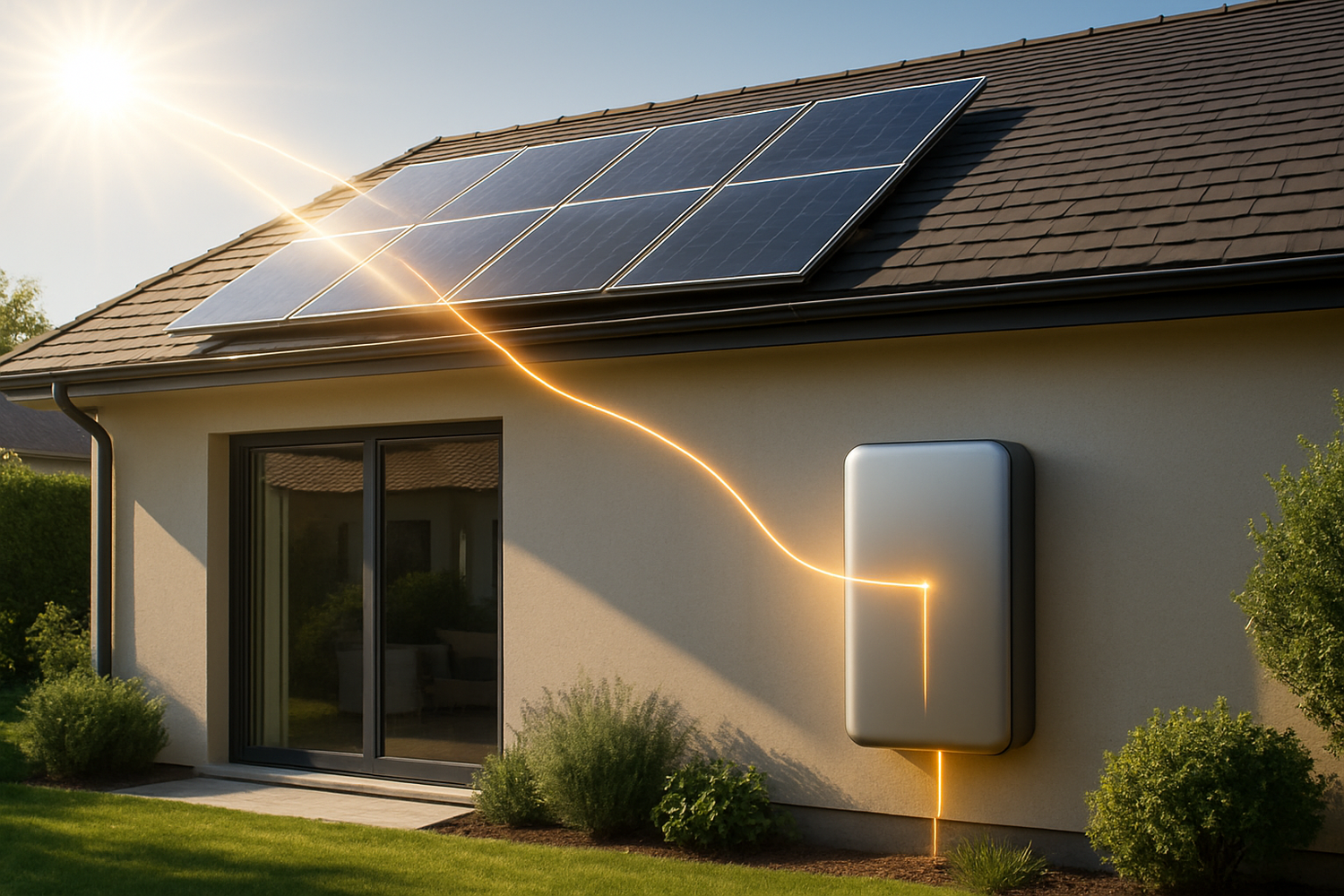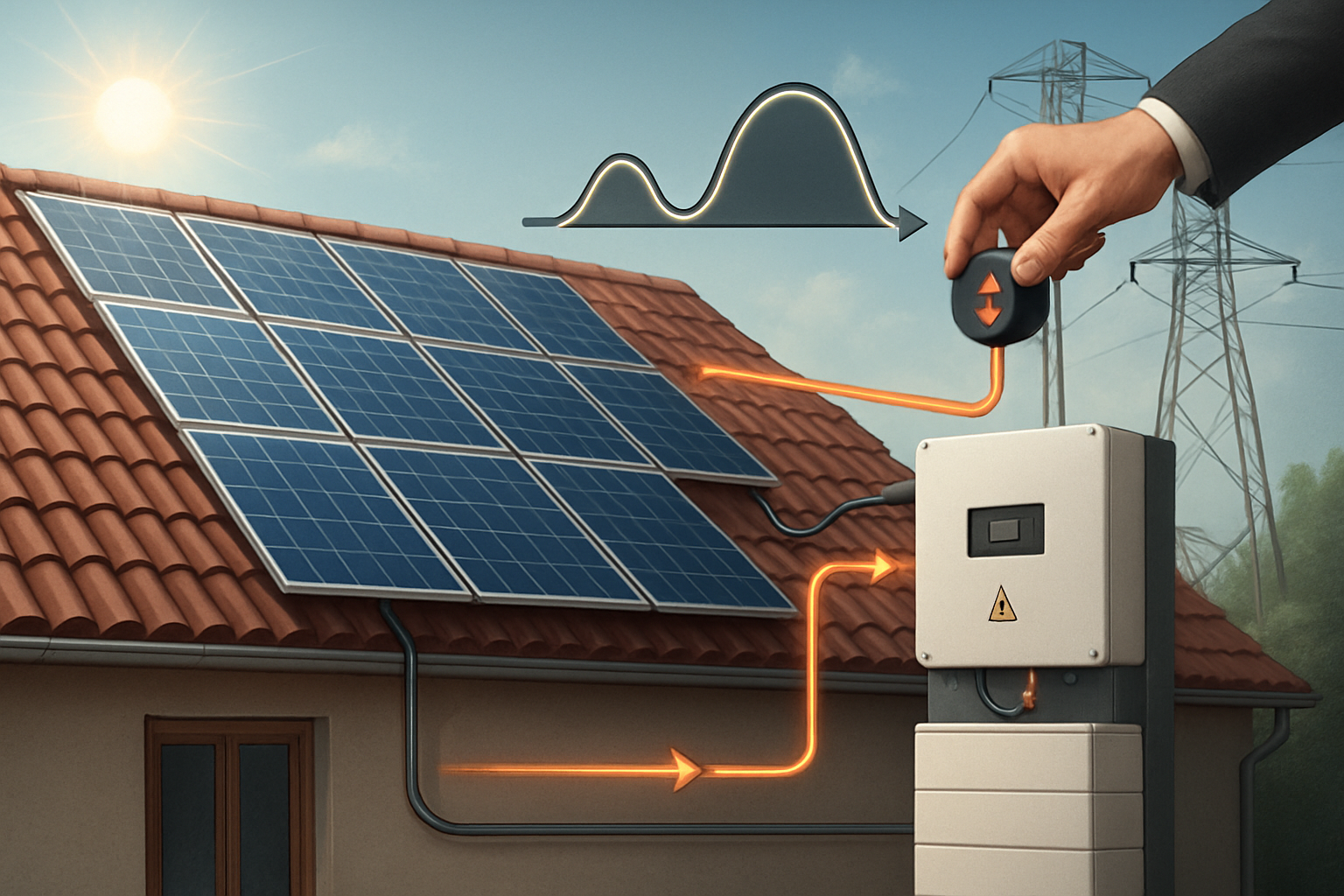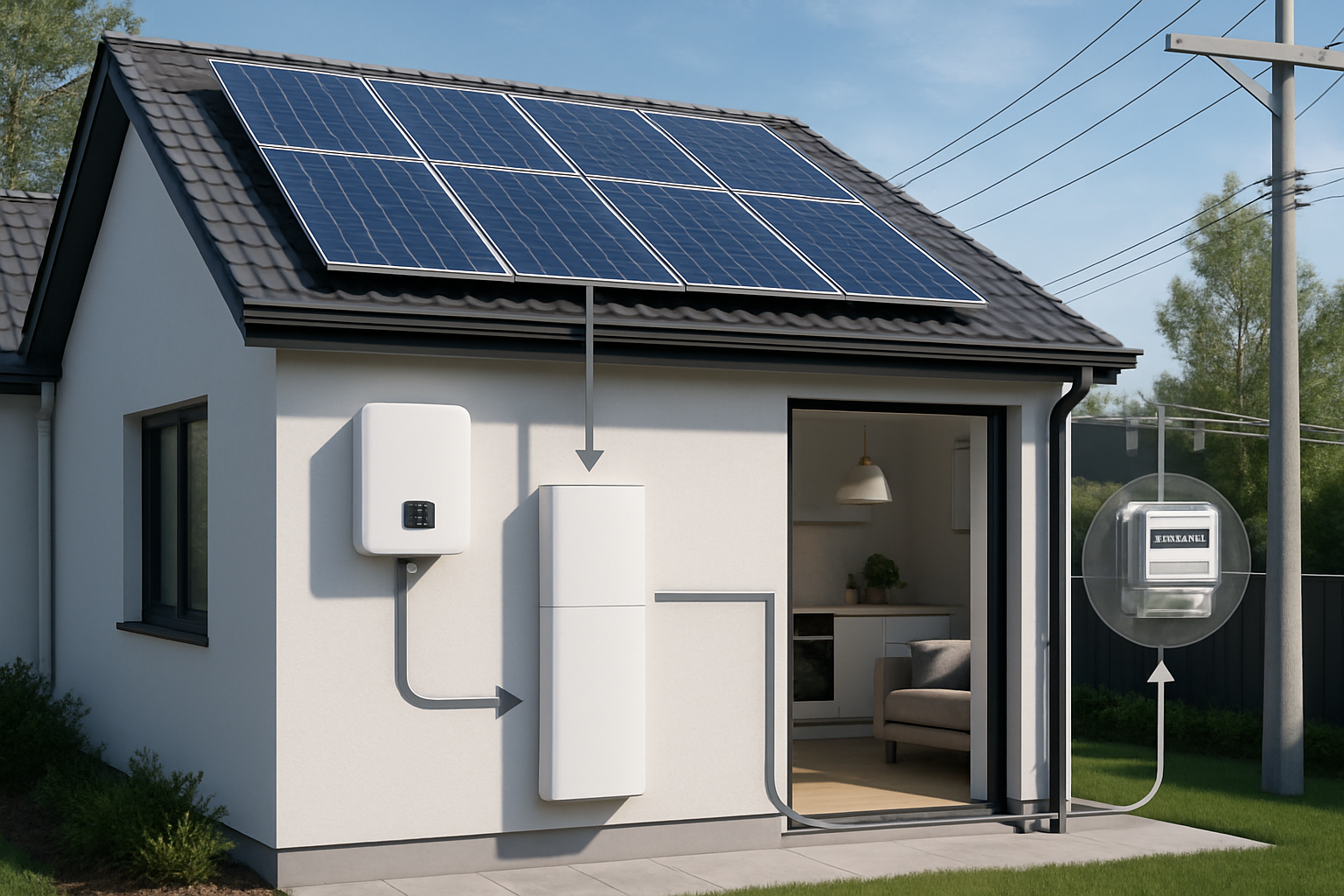Solar energy offers a clean, sustainable power source for homes and businesses. However, a challenge known as PV curtailment can prevent you from fully utilizing the energy your solar panels generate. This occurs when solar power production is intentionally reduced, often leading to wasted potential. Fortunately, integrating home batteries and hybrid solar systems provides effective solutions to overcome this issue, ensuring you capture and use more of your valuable solar energy.
Understanding Solar Curtailment: Why Energy is Lost
What is PV Curtailment?
PV curtailment refers to the deliberate reduction or restriction of electricity generation from solar photovoltaic (PV) systems. This happens when factors like oversupply, grid congestion, or low demand make it difficult for the grid to absorb or distribute the generated power effectively. Curtailment is often a last-resort measure to maintain grid stability, but it results in lost energy and potential revenue.
It is important to distinguish curtailment from solar clipping. Clipping occurs when your solar panels produce more electricity than your inverter can convert due to its limited capacity. The excess energy is simply not utilized. Curtailment, conversely, is an intentional act, often by grid operators, to manage grid conditions.
Causes of Curtailment
Several factors contribute to solar curtailment:
- Grid Congestion: The local electricity grid might lack the capacity to accept surplus solar power, particularly in areas with high solar penetration.
- Oversupply and Low Demand: On sunny days, solar panels may generate more electricity than immediate needs or grid demand. If there isn't enough demand or storage, the excess must be curtailed.
- Economic Factors: During periods of abundant supply and low demand, wholesale electricity prices can become negative. Producers may then choose to curtail generation to avoid financial losses from feeding power into the grid.
- Regulatory Restrictions: Some regions impose regulations or agreements that limit the amount of solar energy a PV system can feed into the grid to prevent overloading.
Home Batteries: Your Solution to Stored Solar Power

Integrating a home battery storage system is a powerful way to combat PV curtailment. These systems store excess solar energy generated during peak production hours, making it available for use when the sun is not shining or when grid demand is high. This approach significantly increases your self-consumption of solar power and reduces reliance on the grid.
How Home Batteries Prevent Curtailment
When your solar panels produce more electricity than your home needs, a home battery system captures that surplus energy instead of letting it be curtailed. This stored energy can then power your home during the evening, on cloudy days, or during peak utility rate periods. By shifting energy consumption, you minimize the amount of power exported to the grid, directly addressing curtailment issues.
Benefits of Integrating Battery Storage
Installing home batteries offers numerous advantages:
- Reduced Electricity Bills: By using your stored solar energy, you draw less power from the grid, especially during expensive peak hours, leading to lower monthly utility costs.
- Increased Energy Independence: A battery system allows you greater control over your energy supply, lessening your dependence on the utility grid. This is particularly valuable in areas with unstable grids or frequent outages.
- Emergency Backup Power: Batteries provide a reliable power source during grid outages, keeping essential appliances running.
- Maximized Solar Energy Utilization: You make the most of every watt your panels produce, preventing valuable solar energy from being wasted due to curtailment.
Lithium Iron Phosphate (LiFePO4) Batteries: A Reliable Choice
For home energy storage, Lithium Iron Phosphate (LiFePO4) batteries have emerged as a leading choice due to their exceptional characteristics. These batteries offer superior safety, thermal stability, and a long operational lifespan.
Key advantages of LiFePO4 batteries include:
- Enhanced Safety: LiFePO4 chemistry is inherently stable, making these batteries less prone to overheating or thermal runaway compared to other lithium-ion chemistries. This reduces the risk of fires, providing peace of mind for homeowners.
- Longer Lifespan: LiFePO4 batteries typically offer a significantly higher number of charge-discharge cycles, often lasting 5-10 times longer than traditional lead-acid batteries.
- High Efficiency: With up to 95% energy transfer efficiency, LiFePO4 batteries ensure that more of your stored solar energy is available for use.
- Robust Performance: They exhibit excellent tolerance to overcharging and over-discharging, contributing to their reliability and durability.
Hybrid Solar Systems: Intelligent Energy Management
Hybrid solar systems represent an advanced approach to managing solar power, combining solar panels, battery storage, and grid interaction into one cohesive unit. The core of these systems is the hybrid inverter.
The Role of Hybrid Inverters
A hybrid inverter is a sophisticated device that integrates the functionalities of a traditional solar inverter (converting DC from panels to AC for home use) with a battery inverter (managing battery charging and discharging). It acts as an intelligent energy hub, directing power flows based on real-time conditions and your preferences.
Hybrid inverters perform several critical functions:
- DC to AC Conversion: They convert the direct current (DC) electricity from your solar panels into alternating current (AC) that your home appliances use.
- Battery Management: They manage the charging of connected batteries with excess solar energy and discharge them when needed.
- Grid Interaction: They can seamlessly switch between solar, battery, and grid power, drawing from the grid when solar or battery reserves are insufficient, or feeding surplus energy back to the grid when appropriate.
Optimizing Energy Flow with Hybrid Systems
Hybrid systems excel at optimizing energy flow to minimize curtailment. During peak sunlight hours, the hybrid inverter prioritizes powering your home directly with solar energy. Any surplus then charges your batteries. Only when batteries are full and your home's demand is met will the system export excess power to the grid, if permitted. This intelligent management ensures maximum self-consumption and reduces wasted solar energy.
Modern hybrid inverters often include intelligent energy management systems that:
- Prioritize real-time energy usage.
- Divert surplus solar energy to battery storage.
- Export energy to the grid only when it is profitable or necessary.
Advanced Strategies for Curtailment Management
Smart Energy Management Systems
Beyond the hardware, intelligent software plays a vital role in curtailment management. Smart energy management systems (EMS) can optimize energy flows between your PV system, batteries, and household loads. These systems often use historical data and weather forecasts to predict solar production and consumption, allowing for proactive energy redirection. For example, an EMS can distribute otherwise curtailed solar power to charge electric vehicles or heat pumps, ensuring no PV power goes to waste.
Such systems also enable strategies like peak shaving, where energy consumption is shifted to periods of high solar production, further minimizing curtailment and potentially lowering costs.
Navigating Export Limits and Grid Regulations
Many utility grids have export limits, which cap the amount of electricity your solar system can feed back into the public grid. These limits are in place to maintain grid stability, prevent voltage fluctuations, and avoid overloading infrastructure.
Home batteries and hybrid inverters are crucial for navigating these regulations. Instead of curtailing excess generation when an export limit is reached, your system can store that energy. This allows you to install a larger solar array to meet your consumption needs without exceeding grid export restrictions. Some regions may even have zero export limits, making battery storage essential for any grid-connected solar installation.
| Scenario | Solar Energy Utilization | Grid Dependence | Curtailment Risk |
|---|---|---|---|
| Solar Only (No Battery) | Moderate (Dependent on real-time demand) | High (For evening/low sun periods) | High (During peak production, low demand) |
| Solar + Home Battery | High (Excess stored for later use) | Low (Reduced reliance on grid) | Low (Excess energy absorbed by battery) |
Realizing Energy Independence: Practical Implementation
Designing Your Curtailment-Reducing System
When designing a solar system to minimize curtailment, consider your average daily energy consumption, peak usage times, and local grid regulations. Proper sizing of your solar array, battery capacity, and inverter type is crucial. A system with an oversized solar array relative to the inverter capacity might experience clipping, but a well-integrated battery and hybrid inverter can effectively manage this by storing excess power.
Working with experienced professionals ensures your system is optimized for your specific needs, maximizing self-consumption and minimizing wasted energy.
Off-Grid and Backup Solutions
For those seeking complete energy autonomy, off-grid solar solutions paired with robust battery storage are ideal. These systems allow homes, farms, or remote cabins to operate entirely independent of the utility grid. For example, on the island of Ta’u in American Samoa, a 1.4 MW PV micro-grid with 6 MWh of Li-ion battery storage drastically reduced diesel generator usage, providing three days of autonomy.
Even for grid-tied homes, a well-designed solar-plus-storage system provides reliable backup power during outages, enhancing household resilience and security. Our company specializes in developing integrated energy storage systems (ESS) that combine high-performance lithium batteries, hybrid inverters, and solar panels to deliver reliable and scalable energy solutions, helping customers achieve true energy independence.
A Path to Maximized Solar Value
PV curtailment represents a significant challenge in the expanding solar energy landscape, leading to wasted renewable energy and missed economic opportunities. However, the widespread adoption of home batteries and sophisticated hybrid solar systems offers a robust solution. By intelligently storing excess solar power and optimizing energy flows, these technologies empower you to maximize your solar investment, enhance energy independence, and contribute to a more stable and sustainable energy future. The ability to manage your energy actively, rather than passively accepting curtailment, transforms how you interact with your power supply, putting control firmly in your hands.
Frequently Asked Questions
What is the difference between solar curtailment and clipping?
Solar curtailment is the intentional reduction of solar power output, often by grid operators, due to factors like oversupply or grid congestion. Solar clipping, on the other hand, occurs when your solar panels generate more electricity than your inverter can process, leading to a portion of the energy being unused by the inverter.
How do home batteries improve solar system efficiency?
Home batteries improve efficiency by storing excess solar energy that would otherwise be curtailed or sent to the grid at low or no compensation. This stored energy can then be used later, such as during the evening or peak demand times, maximizing your self-consumption and reducing your reliance on grid power.
Can a hybrid inverter work without grid connection?
Yes, many hybrid inverters are designed to operate in various modes, including off-grid or stand-alone applications. They can manage power from solar panels and batteries to supply your home independently, making them suitable for remote locations or as a backup power solution during grid outages.
Are there regulations on how much solar power I can export?
Yes, many utility companies and grid operators impose export limits, which restrict the amount of excess solar electricity you can feed back into the grid. These regulations aim to maintain grid stability and prevent overloading. Home batteries and hybrid systems can help you manage these limits by storing surplus energy for your own use.





Leave a comment
All comments are moderated before being published.
This site is protected by hCaptcha and the hCaptcha Privacy Policy and Terms of Service apply.